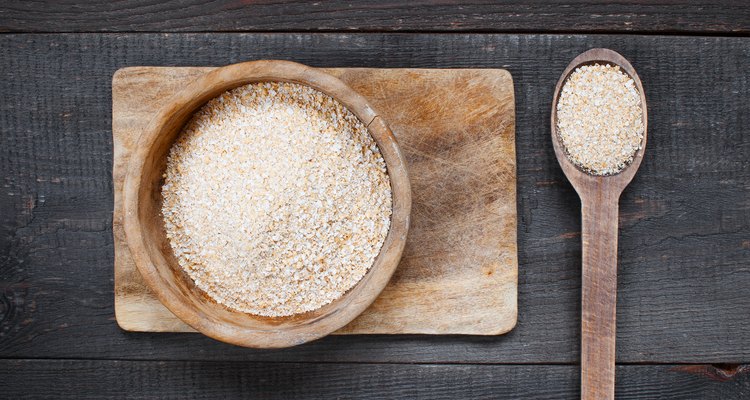
Alinakho/iStock/GettyImages
Oat bran is rich in fiber and helps reduce cholesterol levels in the body. Make into a smooth and creamy hot cereal or add it to baked goods. If you don't have oat bran on hand, or don't care for it, you can use wheat, corn or rice bran instead for cooking and get similar end-results in your baked goods.
These substitutes might change the flavor slightly and have a subtly different texture, but the real difference from oat bran and its substitutes is in the nutritional and fiber content.
Fiber
Bran is the outer layer of grain and a byproduct of processing. Bran derived from different grains, such as wheat, corn and rice, do not have the same structure.
One major difference is the type of fiber they contain. Oat bran and rice bran consist of soluble fibers, which mix with bile acids in the intestine and assist with the elimination of cholesterol, keep blood-sugar levels stable and prevent overeating. A diet rich in soluble fiber is incredibly helpful in reducing levels of LDL, or bad, cholesterol in people with dangerous levels.
Wheat and corn bran consist of insoluble fiber, which passes through the body undigested, adding bulk to the stool, preventing constipation and reducing the risk of colon cancer and diverticulitis. This type of fiber is still valuable, but doesn't have the cholesterol-lowering effects of the fiber found in oat bran.
The amount of fiber contained in each type of bran also differs. Raw oat bran contains 14 grams of fiber per cup. Wheat bran and rice bran both contain just under 25 grams of dietary fiber per cup.
Fiber content is highest in corn bran with 60 grams per cup. You might substitute oatmeal in some recipes containing oat bran and it too contains soluble fiber, but has 50 percent less than oat bran.
Calories
Equal amounts of various forms of crude bran differ in their calorie and fat content. Oat bran contains 231 calories per cup with 6.61 grams of total fat. Crude wheat bran contains 125 calories and two grams of fat.
Corn bran contains 170 calories per cup with less than one gram of fat. Rice bran is highest in calories, supplying 373 per cup with the most total fat — 24.6 grams — consisting of just under five grams of saturated fat. If you're concerned about your fat intake, avoid rice bran as a substitute.
Iron Content
All raw bran made from grain has a high iron content, which is one of its great nutritional perks. One-third cup of raw oat bran supplies 10 percent of the daily value — or DV — for iron. Wheat bran also supplies about 10 percent of the DV for each 1/3 cup serving; rice bran has 53 percent of the DV ; and corn bran has just 3.6 percent of the DV per cup, based on a 2,000-calorie diet.
Related Articles
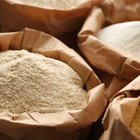
Baking With Almond, Rice & Coconut Flour
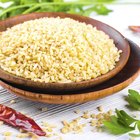
Bulgur Vs. Farro
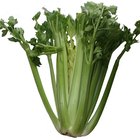
High-Fiber Foods That Do Not Digest
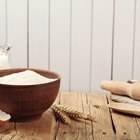
The Nutrition in Coconut Powder

Is Jasmine Rice Naturally White or Is ...

Protein Content of Soy Beans

Are Bean Sprouts Good for You?
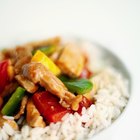
Does Rice Taste Different Depending on ...
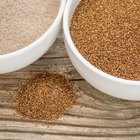
Is Teff Flour Gluten-Free?
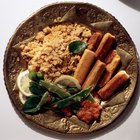
How to Cook Bulgar Wheat in the ...
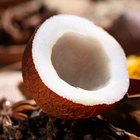
How to Cook With Coconut Flour for Main ...
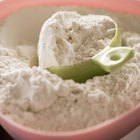
Chemicals in Enriched Flour
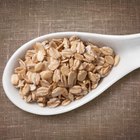
Does Instant Oatmeal Have Less Fiber ...

How to Eat Buckwheat Raw

How Long Do I Cook Vermicelli?

How to Cook Oven-Roasted Corn

Does Benefiber Lower Cholesterol?

What Happens if You Use Brownie Mix ...
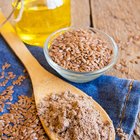
Flaxseeds for Hair & Nail Growth

Substitute for Gram or Besan Flour
References
Writer Bio
Gord Kerr's professional background is primarily in business and management consulting. In 1991, Kerr started writing freelance for a small local newspaper, "The Summerland Review," and a leading sailing publication, "Cruising World Magazine." Kerr has a Bachelor of Business Administration degree from Wilfred Laurier University.